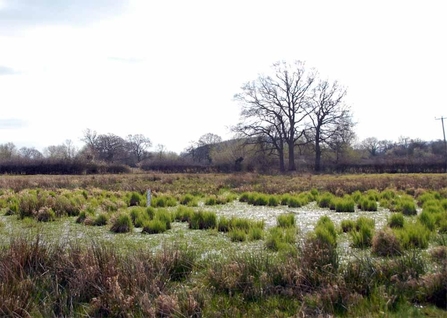Ice Age Ponds are home to complex ecosystems which have survived since the ponds were formed during the last glacial retreat, 20,000 years ago! These ponds have a restricted distribution in the UK, partially due to their formation being dependent on a hummocky moraine, and because many ponds were lost at the end of the 20th century due to development and farming. Here in Herefordshire, approximately 25% of our ponds are still of their natural origin (compared to 2% nationally) highlighting the importance of preserving our Ice Age Ponds and the wonderful wildlife that they hold.
The Vegetation of Ice Age Ponds

A Birches Farm Nature Reserve pond displaying the variety of vegetative structure that can be found in pond ecosystems (c) Kath Beasley
A large aspect of the Ice Age Ponds Project is to send out our army of volunteers to carry out surveys of potential Ice Age Ponds. Volunteers have been trained to survey both the geological and ecological features of these ponds to help us confirm their origin and to build up a picture of the health of Herefordshire’s ponds. One of the aspects of the ecological survey is to identify the different vegetation structures found at the ponds - and even the species present if the volunteer wishes to put their ID skills to the test! By recording the percentage cover of each vegetation type, the survey helps us build a picture of the type of ecosystem present at the site, painting a picture of the health of the state of the pond.

A mix of different vegetation structure (c) Giles King-Salter
Emergent Vegetation
Emergent pond plants are characterized by being rooted in a substrate but maintain most of their mass above the water surface. They can often be found in the shallow waters around the margins of the ponds but can also grow out in the open water. Their structures are more tough and rigid than other aquatic plants to allow them to grow vertically up, emerging through the pond surface. They are the most recognizable type of aquatic plants - mainly because you can see them! Taxa include rushes, sedges and irises. When emergent vegetation grows around the margins of the pond, they play an important role in preventing erosion of the bank by stabilizing it and slowing down water flow into the pond following heavy downpours.

One of our ponds at Sturts North Nature reserve will lots of emergent vegetation, Carex acuta (c) Will Watson
Floating Leaved Vegetation
These plants are also anchored by roots at the bottom of the pond, but their leaves and flowers float on the water surface. Examples of these include water lilies and broad-leaved pondweed.
Submergent Vegetation
Submergent Vegetation comprises of plants that keep the majority of their mass beneath the water surface, therefore sometimes making them a bit harder to spot! These plants are rooted to the substrate at the pond surface and can have leaves that reach the pond surface. This broad category of species provide great underwater habitat for aquatic species such as invertebrates and amphibian larvae as they provide protection from predators. Plants that are fully submerged also play a role in oxygenation of the pond because their leaves release oxygen into the water when they photosynthesis. Species include hornwort, water violet and water crowfoot.

Water Crowfoot (c) Giles King-Salter
Free Floating Vegetation
As the name suggests, this type of vegetation floats freely on the pond surface. These species are able to obtain nutrients straight from the water through their roots. The ability to float freely means these plants can spread and populate new areas of the pond very quickly and can end up covering the whole surface of a pond. A common example of this is duckweed which is not what we want to see on our Ice Age Ponds as it causes all kinds of problems with water quality and can have negative impacts on the pond ecosystem by shading out the vegetation below it.

A close up of duckweed, free floating vegetation (c) Giles King-Salter
Filamentous Algae
Algae filaments are suspended in the water column and have no true root system but some species are able to connect to the pond floor, making it look like submergent vegetation. These tiny filaments are an important food source for many pond species and can absorb nitrates in the water. However in unbalanced ecosystems, they can form thick mats across the surface of the pond and lead to oxygen depletion.
Ideally, a healthy pond ecosystem should contain a mixture of different vegetative structures to create a diverse habitat with a range of features and food sources for aquatic fauna.
Our volunteers certainly have a lot to look out for when it comes to surveying the vegetation of the Ice Age Ponds!

Moccas Lawn Pool with emergent vegetation around the perimeter (c) Kath Beasley

